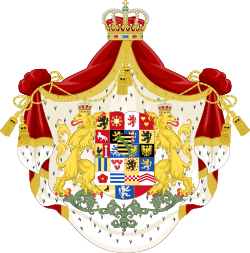
Back Huis van Sakse-Koburg en Gotha Afrikaans بيت ساكس-كوبرغ وغوتا Arabic عيلة ساكس كوبيرج و جوتا ARZ Saksen-Koburq-Qot sülaləsi Azerbaijani Саксен-Кобург-Гоцкая дынастыя Byelorussian Dinastia Saxònia-Coburg i Gotha Catalan Koburkové Czech Huset Sachsen-Coburg og Gotha Danish Haus Sachsen-Coburg und Gotha German Οίκος της Σαξονίας-Κόμπουργκ & Γκότα Greek
| House of Saxe-Coburg and Gotha | |
|---|---|
 | |
| Parent house | House of Wettin |
| Country | |
| Founded | 1826 |
| Founder | Ernest I, Duke of Saxe-Coburg and Gotha |
| Current head | Andreas, Prince of Saxe-Coburg and Gotha |
| Titles | List
|
| Estate(s) | Saxe-Coburg and Gotha, Belgium, Portugal, Bulgaria |
| Deposition | 1918 (in Saxe-Coburg and Gotha) |
| Cadet branches |
|
The House of Saxe-Coburg and Gotha (/ˌsæks ˈkoʊbərɡ ... ˈɡɒθə, - ˈɡɒtə/ SAKS KOH-bərg ... GOT(H)-ə;[1] German: Haus Sachsen-Coburg und Gotha) is a European royal house. It takes its name from its oldest domain, the Ernestine duchy of Saxe-Coburg and Gotha, and its members later sat on the thrones of Belgium, Bulgaria, Portugal, and the United Kingdom and its dominions.
Founded in 1826 by Ernest Anton, the sixth duke of Saxe-Coburg-Saalfeld, it is a cadet branch of the Saxon House of Wettin. One agnatic branch currently reigns in Belgium—the descendants of Leopold I—and another reigned until the death of Elizabeth II in the United Kingdom—the descendants of Albert, Prince Consort.
In 1917, the First World War caused the British king George V to officially change the name from "Saxe-Coburg and Gotha" to "Windsor" in the United Kingdom.[2] In Belgium, due to similar resentment against Germany after the Great War, the use of the name was also changed in 1920 by King Albert I to "de Belgique" (French), "van België" (Dutch) or "von Belgien" (German), meaning "of Belgium". However, the "Saxe-Coburg" house name of the Belgian royal family was never officially abolished, and since relations between Belgium and Germany have been normalized for a long time, the use of this family name has been slowly reintroduced since the 2010s (especially since King Philippe of Belgium wants to limit the number of princes and princesses of Belgium, and thus the use of the designation "of Belgium", to only a select group of his family).[3]
- ^ Jones, Daniel (2003) [1917], Peter Roach; James Hartmann; Jane Setter (eds.), English Pronouncing Dictionary, Cambridge: Cambridge University Press, ISBN 3-12-539683-2
- ^ "The House of Windsor – A Proclamation 1917". British Monarchist Society and Foundation.
- ^ Waarom Delphine de foute naam krijgt – website of the Faculty of Law of KU Leuven